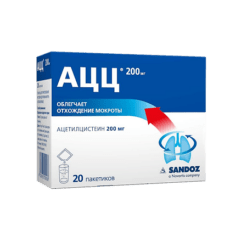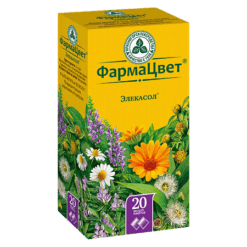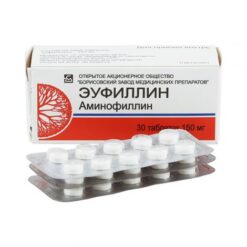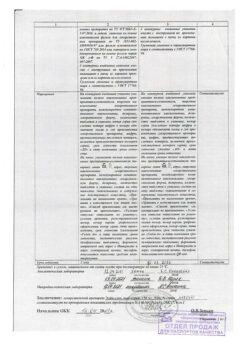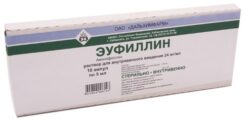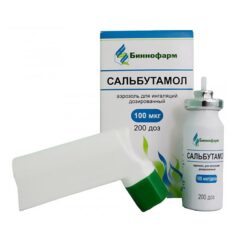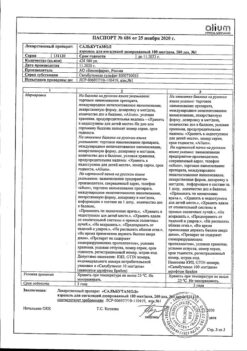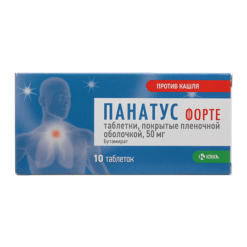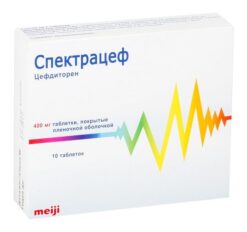No products in the cart.
ATS Active, 600 mg sachet 1,6mg 10 pcs
€4.06 €3.38
Description
Acetylcysteine is a derivative of the amino acid cysteine. It has mucolytic and secretomotor action in the respiratory tract, facilitates expectoration of sputum due to a direct effect on the rheological properties of sputum. The action of the drug is due to the ability of its free sulfhydryl groups to break intra- and intermolecular disulfide bonds of acidic mucopolysaccharides of sputum, which leads to depolymerization of mucoproteins and reduction of sputum viscosity.
In addition it reduces induced hyperplasia of mucoid cells, increases production of surface-active compounds (surfactant) by stimulation of type II pneumocytes and stimulates ciliary activity which leads to improvement of mucociliary clearance.
The drug remains active in the presence of purulent, mucopurulent and mucous sputum.
It increases secretion of less viscous sialomucin by bocalytic cells, reduces bacterial adhesion on the epithelial cells of the bronchial mucosa. Stimulates bronchial mucous membrane cells whose secretion lyses fibrin.
It has the same effect on the secretion formed in inflammatory diseases of the ENT organs.
It has an antioxidant effect due to the presence of sulfhydryl groups (SH-groups) capable of neutralizing electrophilic oxidizing toxins. Acetylcysteine easily penetrates into the cell, where it is deacetylated to L-cysteine from which intracellular glutathione is synthesized.
Glutathione is a highly reactive tripeptide, a powerful antioxidant, cytoprotector that traps endogenous and exogenous free radicals and toxins. Acetylcysteine prevents depletion and promotes increased synthesis of intracellular glutathione that participates in redox processes in cells, thus promoting detoxification of harmful substances. This explains the effect of acetylcysteine as an antidote in paracetamol poisoning.
Paracetamol exerts its cytotoxic effect through progressive depletion of glutathione. The main role of acetylcysteine is to maintain proper levels of glutathione concentration, which provides protection for cells.
It protects alpha-1-antitrypsin (an elastase inhibitor) from the inactivating action of HOCl, an oxidizing agent produced by myeloperoxidase of active phagocytes. It also has anti-inflammatory action (by inhibiting the formation of free radicals and active oxygen-containing substances responsible for the development of inflammation in lung tissue).
When preventive administration of acetylcysteine a decrease of frequency and severity of exacerbations of bacterial infections has been noted in patients with chronic bronchitis and cystic fibrosis.
Indications
Indications
Acute and chronic respiratory diseases associated with the formation of viscous difficult to separate bronchial secretion (as an expectorant): Bronchitis, tracheitis, bronchiolitis, pneumonia, bronchiectatic disease, cystic fibrosis, lung abscess, pulmonary emphysema, laryngotracheitis, interstitial lung diseases, pulmonary atelectasis (due to blockage of the bronchi with mucous plugs).
Inflammation of the middle ear (otitis media), acute and chronic sinusitis, rhinosinusitis (facilitation of secretion).
The removal of viscous secretion from the airways in post-traumatic and post-operative conditions.
Active ingredient
Active ingredient
Composition
Composition
1 sachet contains:
the active ingredient:
acetylcysteine 600 mg;
components:
Glyceryl tripalmitate,
polysorbate 65,
sorbitol,
xylitol,
citric acid,
sodium citrate,
magnesium citrate,
br>
sodium carmellose,
aspartame,
berry flavoring “B” (natural/identical to natural liquid berry flavoring, code 5752; natural/identical to natural liquid berry flavoring, code 5337; vanillin; maltodextrin; mannitol; gluconolactone; sorbitol; colloidal anhydrous silica; magnesium carbonate),
Magnesium stearate.
Interaction
Interaction
The concomitant use of acetylcysteine with anti-cough drugs may result in bronchial sputum congestion due to suppression of the cough reflex. A careful evaluation of the patient is necessary before such combination therapy is prescribed.
The current reports of inactivation by acetylcysteine of antibacterial drugs such as tetracyclines (except doxycycline), aminoglycosides, cephalosporins, penicillins (ampicillin), and antifungal drugs (amphotericin B) refer exclusively to in vitro studies (pharmaceutical incompatibility). Nevertheless, oral antibacterials and Atsz® Active should be used at least 2 hours apart (not applicable to cefixime and loracarbef).
The concomitant use with acetylcysteine may increase the vasodilatory and antiplatelet effects of nitroglycerin. If concomitant use of nitroglycerin and acetylcysteine is required, the patient should be monitored for the potential development of arterial hypotension (sometimes severe, may manifest as headache).
The concomitant use of acetylcysteine and carbamazepine may result in reduction of carbamazepine concentrations to subtherapeutic levels.
The concomitant use of activated charcoal may decrease the effect of acetylcysteine.
Acetylcysteine eliminates the toxic effects of paracetamol.
Directions for use
Directions for use
Internal. The powder from 1 sachet should be poured directly on the tongue. The drug stimulates salivation, so the powder is mixed with saliva and easily swallowed. It is not recommended to wash down with water. Oral powder should not be chewed before swallowing.
Adults: 1 sachet once daily (equivalent to 600 mg of acetylcysteine per day).
Because of the high content of acetylcysteine (600 mg) in 1 sachet, the drug should not be used in children (other dosage forms of AtsC® or other acetylcysteine preparations are recommended).
The duration of treatment should be evaluated individually. In case of short-term colds the course duration is 5-7 days, in case of treatment of chronic diseases – up to several months (according to the doctor’s recommendation).
Special Instructions
Special Instructions
In patients with bronchial asthma and obstructive bronchitis, acetylcysteine should be administered with caution under systemic control of bronchial patency. If the patient is unable to expectorate effectively, drainage or aspiration of the secretion should be performed.
In the use of acetylcysteine, severe allergic reactions such as Stevens-Johnson syndrome and Lyell syndrome have very rarely been reported. If changes of the skin and mucous membranes occur, it is necessary to consult a physician immediately, the drug should be discontinued.
Do not take the drug immediately before going to bed (it is recommended to take the drug before 6 pm).
The effect on laboratory data. Acetylcysteine may affect the results of colorimetric determination of plasma concentration of salicylates. In urinalysis, acetylcysteine may affect the results of ketone body determination.
Influence on the ability to drive vehicles, mechanisms
Acetylcysteine has no effect on the ability to drive vehicles and operate mechanisms.
Synopsis
Synopsis
Features
Features
Acetylcysteine is quickly and almost completely absorbed when taken orally. Due to high presystemic metabolism (effect of “primary passage” through the liver) the bioavailability of oral forms of acetylcysteine is about 10%. Maximal concentration (Cmax) of acetylcysteine in blood plasma after oral administration is reached after 1-3 hours and is 15 mmol/l, Cmax of cysteine metabolite is approximately 2 µmol/l.
Distribution
The binding to plasma proteins is about 50% after 4 h and decreases to 20% after 12 h.
Acetylcysteine is distributed both unchanged (20%) and in the form of active metabolites (80%), penetrates into intercellular space, distributed mainly in liver, kidneys, lungs and bronchial secretion. Acetylcysteine penetrates the placental barrier and is determined in umbilical cord blood. There is no information on excretion into breast milk. There are no data on the ability of acetylcysteine to penetrate the blood-brain barrier.
Metabolism
Acetylcysteine is metabolized in the liver to cysteine, a pharmacologically active metabolite, as well as to diacetylcysteine, cystine and other mixed disulfides. In the body acetylcysteine and its metabolites can be detected in different forms: in free form, bound to plasma proteins by labile disulfide bonds or as bound amino acids.
Contraindications
Contraindications
History of gastric or duodenal ulcer, bronchial asthma, obstructive bronchitis, hepatic and/or renal insufficiency, histamine intolerance (long-term use should be avoided,
because acetylcysteine affects histamine metabolism, which may lead to the appearance of symptoms of intolerance, such as headache, vasomotor rhinitis, itching), esophageal varices, adrenal disorders, arterial hypertension.
Side effects
Side effects
infrequent: hypersensitivity reactions;
very rare: anaphylactic shock, anaphylactic/anaphylactoid reactions.
Nervous system disorders
infrequent: headache.
Heart and vascular disorders
infrequent: tachycardia, arterial hypotension;
very rare: bleeding*;
frequency unknown: cases of collapse have been described when acetylcysteine is taken.
Respiratory system disorders
rarely: dyspnea, bronchospasm (mainly in patients with bronchial hyperresponsiveness due to bronchial asthma).
Gastrointestinal disorders
infrequent: abdominal pain, nausea, vomiting, diarrhea, stomatitis;
rarely: dyspepsia;
frequency unknown: heartburn.
Skin and subcutaneous tissue disorders
frequent: urticaria, exanthema, rash, angioedema, pruritus;
very rare: Stevens-Johnson syndrome, Lyell’s syndrome (see section “Special Indications”).
Hearing and labyrinth disorders
infrequent: tinnitus.
General disorders
infrequent: fever;
frequency unknown: facial edema.
* Single reports of bleeding with acetylcysteine, sometimes together with hypersensitivity reactions. Decrease of platelet aggregation with acetylcysteine has been confirmed in some studies; clinical significance of this phenomenon has not yet been determined.
Overdose
Overdose
Toxic overdose in oral acetylcysteine has not been described. Acetylcysteine when administered in doses up to 500 mg/kg/day did not cause symptoms of overdose. Healthy volunteers received acetylcysteine at a dose of 11.6 g per day for 3 months without developing any serious adverse reactions.
Symptoms: gastrointestinal manifestations such as nausea, vomiting, and diarrhea may be observed.
Treatment: symptomatic therapy if necessary.
Similarities
Similarities
Additional information
| Shelf life | 2 years. Do not use after the expiration date printed on the package. |
|---|---|
| Conditions of storage | Store in the original package at a temperature not exceeding 25 ° C. Store out of the reach of children. |
| Manufacturer | Hermes Pharma Ges.M.b.H., Austria |
| Medication form | oral powder |
| Brand | Hermes Pharma Ges.M.b.H. |
Other forms…
Related products
Buy ATS Active, 600 mg sachet 1,6mg 10 pcs with delivery to USA, UK, Europe and over 120 other countries.


